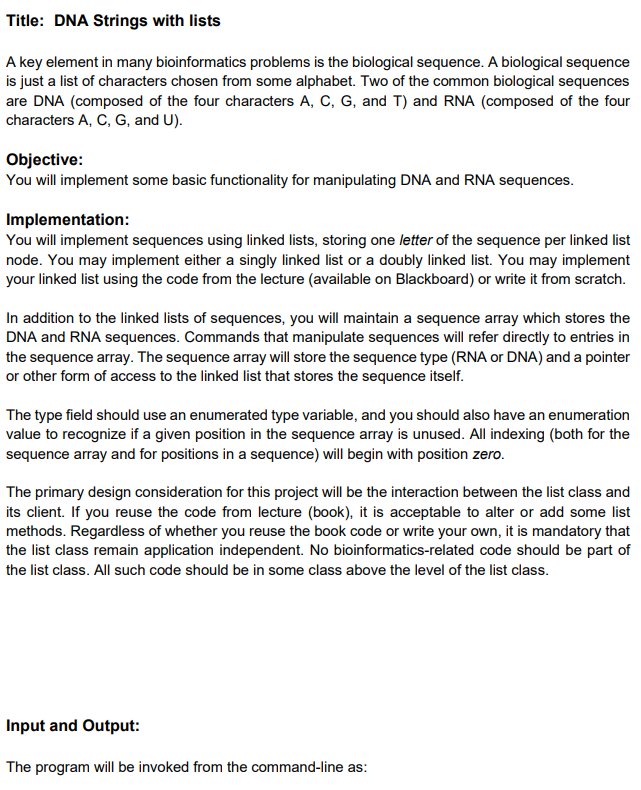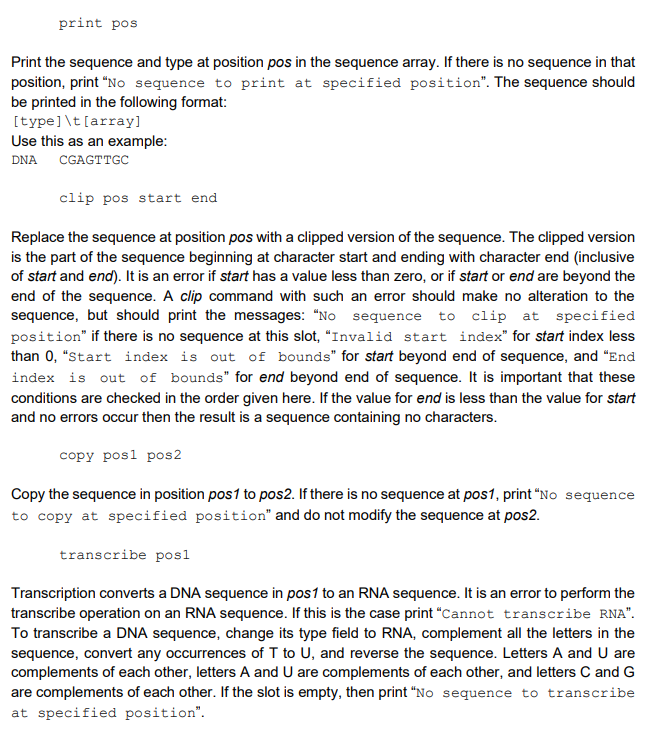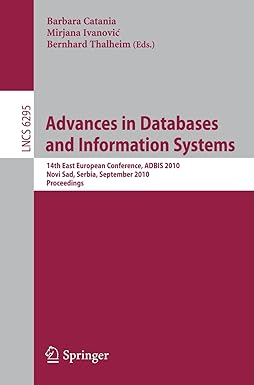


Input:
insert 0 DNA AATTCCGGAATTCCGG insert 2 RNA UAGACAUGGAUU insert 1 DNA ABCDE insert 1 RNA TTTT insert 4 DNA AATTCCGGAATTCCGG print remove 1 remove 4 print print 0 print 2 print 4 clip 0 0 7 print 0 clip 0 0 12 clip 0 -1 3 clip 1 3 10 insert 1 DNA TACAGACAT clip 1 10 3 print copy 4 1 copy 0 1 print transcribe 2 transcribe 4 transcribe 1 print 1
Output:
Error occurred while inserting Error occurred while inserting 0 DNA AATTCCGGAATTCCGG 2 RNA UAGACAUGGAUU 4 DNA AATTCCGGAATTCCGG No sequence to remove at specified position 0 DNA AATTCCGGAATTCCGG 2 RNA UAGACAUGGAUU DNA AATTCCGGAATTCCGG RNA UAGACAUGGAUU No sequence to print at specified position DNA AATTCCGG End index is out of bounds Invalid start index No sequence to clip at specified position Start index is out of bounds 0 DNA AATTCCGG 1 DNA TACAGACAT 2 RNA UAGACAUGGAUU No sequence to copy at specified position 0 DNA AATTCCGG 1 DNA AATTCCGG 2 RNA UAGACAUGGAUU Cannot transcribe RNA No sequence to transcribe at specified position RNA CCGGAAUU
In Java please (linked list)
To insert the sequence, use a file reader and read the input from a text file.
Also important:

Title: DNA Strings with lists A key element in many bioinformatics problems is the biological sequence. A biological sequence is just a list of characters chosen from some alphabet. Two of the common biological sequences are DNA (composed of the four characters A, C, G, and T) and RNA (composed of the four characters A, C, G, and U). Objective: You will implement some basic functionality for manipulating DNA and RNA sequences. Implementation: You will implement sequences using linked lists, storing one letter of the sequence per linked list node. You may implement either a singly linked list or a doubly linked list. You may implement your linked list using the code from the lecture (available on Blackboard) or write it from scratch. In addition to the linked lists of sequences, you will maintain a sequence array which stores the DNA and RNA sequences. Commands that manipulate sequences will refer directly to entries in the sequence array. The sequence array will store the sequence type (RNA or DNA) and a pointer or other form of access to the linked list that stores the sequence itself. The type field should use an enumerated type variable, and you should also have an enumeration value to recognize if a given position in the sequence array is unused. All indexing (both for the sequence array and for positions in a sequence) will begin with position zero. The primary design consideration for this project will be the interaction between the list class and its client. If you reuse the code from lecture (book), it is acceptable to alter or add some list methods. Regardless of whether you reuse the book code or write your own, it is mandatory that the list class remain application independent. No bioinformatics-related code should be part of the list class. All such code should be in some class above the level of the list class. Input and Output: The program will be invoked from the command-line as: java DNAList
The name of the program is DNAList. Parameter is the size of the sequence array, and is the input file with the commands to be processed by the program. For the input provided an example of the correct command for arraysize of 20 is: java DNAList 20 Lab4 Test.txt The input for this project will consist of a text file with a series of commands (some with parameters separated by spaces) with at most one command in each line. A blank line may appear anywhere in the command file, and any number of spaces may separate parameters. You need not worry about checking for syntactic errors. That is, only the specified commands will appear in the file, and the specified parameters will always appear. However, you must check for logical errors. These include attempts to access out-of-bounds positions in the sequence array or in a sequence. The output will be written to standard output. The program should terminate after reading the EOF mark. The commands your code should implement are as follows: insert pos type sequence Insert sequence to position pos in the sequence array. Type will be either DNA or RNA. You must check that sequence contains only appropriate letters for its type, if not the insert operation is in error and no change should be made to the sequence array. If this is the case print "Error occurred while inserting". If there is already a sequence at pos and if the sequence is syntactically correct, then the new sequence replaces the old one at that position. It is acceptable that sequence be null (contain no characters) in which case a null sequence will be stored at pos. Note that a null sequence in a sequence array slot is different from an empty slot. remove pos Remove the sequence at position pos in the sequence array. Be sure to set the type field to indicate that this position is now empty. If there is no sequence at pos, print "No sequence to remove at specified position". print Print out all sequences in the sequence array. For each sequence indicate its position in the sequence array and its type (RNA or DNA). Don't print anything for slots in the sequence array that are empty. The sequence array should be printed in the following format: [pos] \t[type] \t[array] Use this as an example: 3 RNA UGCUAC 5 DNA CGAGTTGC print pos Print the sequence and type at position pos in the sequence array. If there is no sequence in that position, print No sequence to print at specified position". The sequence should be printed in the following format: [type] \t(array] Use this as an example: DNA CGAGTTGC clip pos start end Replace the sequence at position pos with a clipped version of the sequence. The clipped version is the part of the sequence beginning at character start and ending with character end (inclusive of start and end). It is an error if start has a value less than zero, or if start or end are beyond the end of the sequence. A clip command with such an error should make no alteration to the sequence, but should print the messages: No sequence to clip at specified position" if there is no sequence at this slot, "Invalid start index" for start index less than 0, "Start index is out of bounds" for start beyond end of sequence, and "End index is out of bounds" for end beyond end of sequence. It is important that these conditions are checked in the order given here. If the value for end is less than the value for start and no errors occur then the result is a sequence containing no characters. copy posl pos2 Copy the sequence in position pos1 to pos2. If there is no sequence at pos1, print No sequence to copy at specified position" and do not modify the sequence at pos2. transcribe pos1 Transcription converts a DNA sequence in pos1 to an RNA sequence. It is an error to perform the transcribe operation on an RNA sequence. If this is the case print "Cannot transcribe RNA". To transcribe a DNA sequence, change its type field to RNA, complement all the letters in the sequence, convert any occurrences of T to U, and reverse the sequence. Letters A and U are complements of each other, letters A and U are complements of each other, and letters C and G are complements of each other. If the slot is empty, then print "No sequence to transcribe at specified position". Ensure that you have your main executable file named 'DNAList.java'. You should also include all other necessary java files in your submission, such as linked list implementation. Ensure that your program prints output in the format specified here and in the provided *ans files. Any additional white spaces and blank line variations do not affect the grading of your output. However, any variations in characters do affect grading. For example, if you print the array as [A, T, C, G or ATC G instead of ATCG the output of your file will not pass the testing script. Title: DNA Strings with lists A key element in many bioinformatics problems is the biological sequence. A biological sequence is just a list of characters chosen from some alphabet. Two of the common biological sequences are DNA (composed of the four characters A, C, G, and T) and RNA (composed of the four characters A, C, G, and U). Objective: You will implement some basic functionality for manipulating DNA and RNA sequences. Implementation: You will implement sequences using linked lists, storing one letter of the sequence per linked list node. You may implement either a singly linked list or a doubly linked list. You may implement your linked list using the code from the lecture (available on Blackboard) or write it from scratch. In addition to the linked lists of sequences, you will maintain a sequence array which stores the DNA and RNA sequences. Commands that manipulate sequences will refer directly to entries in the sequence array. The sequence array will store the sequence type (RNA or DNA) and a pointer or other form of access to the linked list that stores the sequence itself. The type field should use an enumerated type variable, and you should also have an enumeration value to recognize if a given position in the sequence array is unused. All indexing (both for the sequence array and for positions in a sequence) will begin with position zero. The primary design consideration for this project will be the interaction between the list class and its client. If you reuse the code from lecture (book), it is acceptable to alter or add some list methods. Regardless of whether you reuse the book code or write your own, it is mandatory that the list class remain application independent. No bioinformatics-related code should be part of the list class. All such code should be in some class above the level of the list class. Input and Output: The program will be invoked from the command-line as: java DNAList The name of the program is DNAList. Parameter is the size of the sequence array, and is the input file with the commands to be processed by the program. For the input provided an example of the correct command for arraysize of 20 is: java DNAList 20 Lab4 Test.txt The input for this project will consist of a text file with a series of commands (some with parameters separated by spaces) with at most one command in each line. A blank line may appear anywhere in the command file, and any number of spaces may separate parameters. You need not worry about checking for syntactic errors. That is, only the specified commands will appear in the file, and the specified parameters will always appear. However, you must check for logical errors. These include attempts to access out-of-bounds positions in the sequence array or in a sequence. The output will be written to standard output. The program should terminate after reading the EOF mark. The commands your code should implement are as follows: insert pos type sequence Insert sequence to position pos in the sequence array. Type will be either DNA or RNA. You must check that sequence contains only appropriate letters for its type, if not the insert operation is in error and no change should be made to the sequence array. If this is the case print "Error occurred while inserting". If there is already a sequence at pos and if the sequence is syntactically correct, then the new sequence replaces the old one at that position. It is acceptable that sequence be null (contain no characters) in which case a null sequence will be stored at pos. Note that a null sequence in a sequence array slot is different from an empty slot. remove pos Remove the sequence at position pos in the sequence array. Be sure to set the type field to indicate that this position is now empty. If there is no sequence at pos, print "No sequence to remove at specified position". print Print out all sequences in the sequence array. For each sequence indicate its position in the sequence array and its type (RNA or DNA). Don't print anything for slots in the sequence array that are empty. The sequence array should be printed in the following format: [pos] \t[type] \t[array] Use this as an example: 3 RNA UGCUAC 5 DNA CGAGTTGC print pos Print the sequence and type at position pos in the sequence array. If there is no sequence in that position, print No sequence to print at specified position". The sequence should be printed in the following format: [type] \t(array] Use this as an example: DNA CGAGTTGC clip pos start end Replace the sequence at position pos with a clipped version of the sequence. The clipped version is the part of the sequence beginning at character start and ending with character end (inclusive of start and end). It is an error if start has a value less than zero, or if start or end are beyond the end of the sequence. A clip command with such an error should make no alteration to the sequence, but should print the messages: No sequence to clip at specified position" if there is no sequence at this slot, "Invalid start index" for start index less than 0, "Start index is out of bounds" for start beyond end of sequence, and "End index is out of bounds" for end beyond end of sequence. It is important that these conditions are checked in the order given here. If the value for end is less than the value for start and no errors occur then the result is a sequence containing no characters. copy posl pos2 Copy the sequence in position pos1 to pos2. If there is no sequence at pos1, print No sequence to copy at specified position" and do not modify the sequence at pos2. transcribe pos1 Transcription converts a DNA sequence in pos1 to an RNA sequence. It is an error to perform the transcribe operation on an RNA sequence. If this is the case print "Cannot transcribe RNA". To transcribe a DNA sequence, change its type field to RNA, complement all the letters in the sequence, convert any occurrences of T to U, and reverse the sequence. Letters A and U are complements of each other, letters A and U are complements of each other, and letters C and G are complements of each other. If the slot is empty, then print "No sequence to transcribe at specified position". Ensure that you have your main executable file named 'DNAList.java'. You should also include all other necessary java files in your submission, such as linked list implementation. Ensure that your program prints output in the format specified here and in the provided *ans files. Any additional white spaces and blank line variations do not affect the grading of your output. However, any variations in characters do affect grading. For example, if you print the array as [A, T, C, G or ATC G instead of ATCG the output of your file will not pass the testing script










